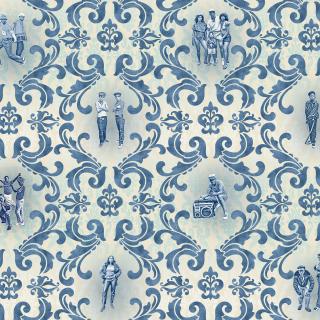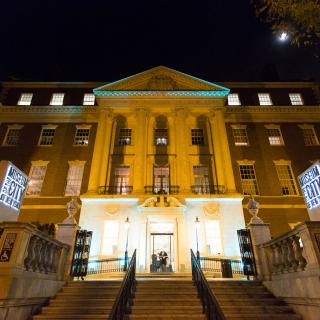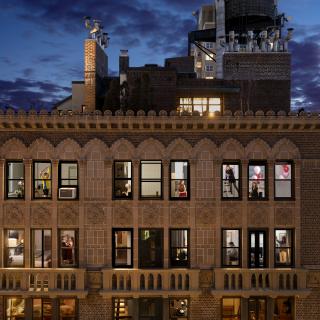New York Now: Home Is a Haven

Home is a Haven
For whom is home a safe place? For whom is it a site of confinement rather than freedom? Contemporary photographers have probed both the oppression of home life and its promise of literal and figurative shelter, as the events of recent years have deeply disrupted the idyll of home as a refuge. When the COVID-19 pandemic lockdowns began in March 2020, New Yorkers found themselves united in their isolation, with many confined to their homes for months at a time. Neil Kramer used photography to make light of an awkward living arrangement, while mother-son duo Chantal Heijnen and Lou van Melik bonded over photography as a means of escaping bleakness.
Long before the pandemic, many other New Yorkers intimately understood that safety within a home is not automatically granted, but must be hard earned. Sara Bennett and Geralyn Shukwit have worked collaboratively on long-term projects with formerly incarcerated women and unhoused people, respectively, with the resulting photographs a searing testament to the difficult, quite literal, labor of building safe homes. As many artists in this exhibition—such as Laylah Amatullah Barrayn, Roy Baizan, and Linda Troeller—have documented, making home into a haven is an act best done collectively. And when a dwelling can actually be transformed by its inhabitants into a place of respite, as Sally Davies’s photographs reveal, home becomes a truly beautiful thing.
SARA BENNETT
1. Evelyn, 2017
2. Veronica, 2021
3. Judy, 2019
4. Shirelle, 2017
From the series “Life after Life in Prison: The Bedroom Project”
ARCHIVAL PIGMENT PRINTS
Sara Bennett is a Brooklyn-based public defender-turned-photographer who uses photography to raise awareness about the prison-industrial complex’s harmful effects on society and the two million people currently incarcerated in US prisons and jails. Her ongoing series “Life after Life in Prison: The Bedroom Project,” works to remind judges, legislators, and the larger public that everyone has families, dreams, and a basic right to safe housing by sharing the stories of formerly incarcerated women in their most intimate spaces—their bedrooms.
At the time Bennett photographed the women, some had only been recently paroled from extremely long prison sentences, while others had spent many years on the outside and were living in more stable homes. Handwritten personal reflections and anecdotes accompany each bedroom photo, highlighting both the joys and the great challenges of completely remaking one’s life after spending decades behind bars. As Judy, whose photo is included in New York Now, shares, “To be my own person, in my own time and place. Simply, a miracle.”
CHANTAL HEIJNEN
1. 4:56:56 PM, March 28, 2020
2. 08:52:25 AM, April 28, 2020
3. 01:32:28 PM, March 26, 2020
4. 06:06:29 PM, April 18, 2020
5. 04:55:30 PM, March 28, 2020
6. 08:55:22 PM, April 3, 2020
7. 08:12:24 AM, May 9, 2020
8. 05:32:40 AM, April 2, 2020
9. 05:38:02 AM, April 4, 2020
10. 12:35:40 PM, April 2, 2020
LOU VAN MELIK
11. Sea of Buildings, April 22, 2020
12. Van Guggenheim, May 3, 2020
13. Inside Out, April 15, 2020
14. Bridge of Courage, April 30, 2020
From the series “Lou’s Summer”
ARCHIVAL PIGMENT PRINTS
In March of 2020, New York City was the epicenter of the COVID-19 pandemic, sending the city into a complete lockdown. For Harlem-based photographer Chantal Heijnen and her family, the pandemic turned their lives upside down, yet it also resulted in a unique photographic collaboration with her then six-year- old son Lou van Melik.
The family rented a car, allowing them to escape from a small apartment to places like Coney Island and Orchard Beach. Lou decided to use an old camera and began to take photographs of “his” New York from the back seat. He began to see the city in new ways, as he had never seen it before. In turn, Chantal started to take pictures of Lou in intimate moments that show the changes to the patterns of time use during the lockdown. Later that summer, the family traveled to the Netherlands, where the project continued for several months and resulted in their book Lou’s Summer. For the photographers, image making was a therapeutic experience, one that resulted in a remarkable window into one family’s perspective on the pandemic.
NEIL KRAMER
1. Quarantine in Queens, Day 26, April 7, 2020
2. Quarantine in Queens, Day 8, March 2020
3. Quarantine in Queens, Day 173, September 7, 2020
CHROMOGENIC DEVELOPMENT PRINTS
The COVID-19 pandemic has had a tremendous impact on countless New Yorkers, often upending lives. The lockdown that began in the spring of 2020 led to people staying home, self-quarantining, and other sometimes desperate measures to keep from getting sick. Neil Kramer spent several months holed up in a small, two-bedroom, one-bathroom Queens apartment with his mother—who is in her late eighties—and his ex-wife. Kramer explains, “It was supposed to be a few weeks. My mother was supposed to be in Florida, but that fell through and my ex-wife’s place in Los Angeles flooded, so they both came to New York.”
Usually a writer and a street photographer, Kramer turned to his camera as solace. He created elaborately staged vignettes with his mother, Elaine, and his ex-wife, Sophia Lansky, a Hebrew and Russian language translator, reflecting the humor and humanity of the situation. Kramer says, “This became self-therapy for the three of us."
LAYLAH AMATULLAH BARRAYN
1. In Her Former Job at an Energy Management Company, Ms. Colón Would Commute From Manhattan to Sites That She Supervised in Brooklyn
2. Ms. Colón Gives a Briefing at a Housing Project in Brooklyn as Part of Her Former Job at an Energy Management Company
3. Ms. Colón With Her Mother, Charmayne Stubbs, and Her Daughter, Paityn, in Harlem
4. Ms. Colón Waiting in the Lobby of a Community Center in Harlem
From the series “Juggling Motherhood and Work,” 2017
CHROMOGENIC DEVELOPMENT PRINTS
Laylah Amatullah Barrayn’s photographic practice uplifts Blackness in all its forms, from her documentary and portrait photography to her co-authored groundbreaking anthology MFON: Women Photographers of the African Diaspora. Barrayn says, “When people look at my pictures I want them to feel like they are part of a celebration of Black beauty, Black excellence, Black intellect, and Black joy.”
In “Juggling Motherhood and Work,” Barrayn turns her gaze towards Black mothers. Created while on assignment for The New York Times, she follows a young mother, Precious Colón, over the course of a workday between her home in Harlem to her job in Brooklyn at Green City Force, a program that prepares young people from low-income families for careers in the renewable energy industry. The gendered labor of caretaking is evident throughout the series— from Ms. Colón holding her daughter in her lap throughout the day, to her supervision of trainees at the office. Barrayn’s photographs are sympathetic but not romantic, they show the difficult work that Black women do in all spheres and honor mothering as a vital form of labor that has literally changed the world.
LINDA TROELLER
1. Mail Boxes, Chelsea Hotel, 2000
2. Chelsea Hotel Lobby, 2005
3. Balcony, Chelsea Hotel, 2006
4. Jeweler, Chelsea Hotel, 2018
5. Man-Lai, Chelsea Hotel, 2018
ARCHIVAL PIGMENT PRINTS
The Chelsea Hotel was one of the preeminent cultural and artistic hubs in Manhattan throughout the 20th century. It was a standard bearer for the bohemian community and served as home to a range of creatives, from writers Dylan Thomas to Arthur Miller, cinematic figures like Stanley Kubrick and Ethan Hawke, and musicians from Bob Dylan to Sid Vicious. From 1994 until 2013, Linda Troeller lived in the hotel and photographed its creative community in residents’ private rooms and the shared common spaces.
The hotel was closed to new guests and tenants when it was sold in 2011; the art was quickly taken off the walls and disruptive renovations began. Some artists were forced out due to back rent and others chose to leave. For Troeller, a mold infestation in her room caused an unbearable, abrasive reaction. She moved out in 2013 while facing eviction, but eventually returned to photograph again in 2018.
SALLY DAVIES
1. Gracie Mansion, Upper West Side, October 3, 2019
2. Marina Press Granger, East Village, August 19, 2019
3. Bara and Roger De Cabrol, East Village, September 13, 2019
4. Michael McMahon, East Village, August 22, 2019
ARCHIVAL PIGMENT PRINTS
MUSEUM OF THE CITY OF NEW YORK. MUSEUM PURCHASES, 2022.16.12, 2022.16.27, 2022.16.52, 2022.16.70
Canadian-born Sally Davies moved to New York City’s East Village in 1983 and focused on painting throughout the ’80s and ’90s. By 2000, Davies shifted her attention to photography, as she began to notice the physical change and demographic shift taking hold in her neighborhood. She has since become known for her keenly observed chromatic street photographs of the rhythms of the city as it continues to change.
Much of New York’s life takes place in these public spaces, but Davies has shifted much of her recent work to private spaces, behind closed doors to make environmental portraits of long-time city dwellers inside their apartments. Often idiosyncratic, these images reflect the lifestyles and personalities of her subjects. These spaces are a refuge from the often-dramatic changes happening in the city around them.
GERALYN SHUKWIT
1. It Was Only 21 Degrees When the Sun Was Out, January 21, 2022
2. Randy and His Homemade Guitar, November 10, 2020
3. Home, June 15, 2015
4. Coffee Time, September 14, 2021
ARCHIVAL PIGMENT PRINTS
For 15 years, Geralyn Shukwit has befriended and photographed people living on New York City’s streets, aiming to raise awareness about the city’s housing crisis. As of September 2022, there are 60,252 homeless people, including 19,310 children, sleeping each night in the city’s main municipal shelter system. Approximately 2,000 more people are living unsheltered—sleeping on the subways, the streets, or in shelters they created for themselves.
Geralyn met Randy in 2014 while walking after work. When she noticed his bike lights flashing, she wanted to make sure he knew they were on so the batteries didn’t die before he really needed them. At this, Randy gave a little laugh and explained that he always leaves the lights on. For 10 years, Randy has made an unassuming bike trailer his home, and the lights are his means of protection. By alerting cars of his presence in the trailer, the lights keep him from being hit. Shukwit describes Randy as “a builder, a thinker, a survivor and 100% a musician. He made this guitar from a wine box around 2017, and on nice days you’ll often find him learning new songs from a playbook a friend gave to him.” In these photographs, made and shared with Randy’s consent, we can see his ingenuity, creativity, and resilience at work.
PAUL MOAKLEY
1. Christina and Her Friends Gather For Breakfast Around 8 AM Before Heading Into Manhattan For SantaCon, Tottenville, Staten Island, December 11, 2021
2. Pageant Queens with Their Escort Drive By in the 4th of July Parade, Travis, Staten Island, July 4, 2021
3. Frankie and His Prom Date, Great Kills, Staten Island, June 9, 2017
4. 4th of July Eve, Oakwood Beach, Staten Island, July 4, 2020
5. Family and Friends Arrive at My Sister’s House For a Pre-prom Party, Tottenville, Staten Island, June 2, 2019
ARCHIVAL PIGMENT PRINTS
Paul Moakley was born in Queens and raised on Staten Island. He is the caretaker and curator at the Alice Austen House Museum and is an executive producer at The New Yorker. As one who works regularly in the media, Moakley sees Staten Island as an underrepresented place in the culture of New York City, and one that is often viewed through a very narrow lens. As a queer artist, Moakley has stated, “I feel an uncomfortable affinity towards Staten Island as my home and a place that shaped my identity. As a young person raised in a conservative and religious community, I felt like an outsider. But today I've had time to grow and find a distance from this place. I have a much stronger sense of self, and I dearly love my family and the supportive communities I've found here.”
From his unique vantage point, Staten Island has been a recurring subject as he continues to photograph local community events and his closest community of family and friends. He even returned to his Catholic high school, and has been photographing its current students and campus community for the past 20 years. In Moakley’s photographs of Staten Island, we see everyday life, a microcosm of America where our most pressing issues play out on a daily basis.
Image Credit: Sara Bennett, Evelyn, 2017. Courtesy of the artist.






